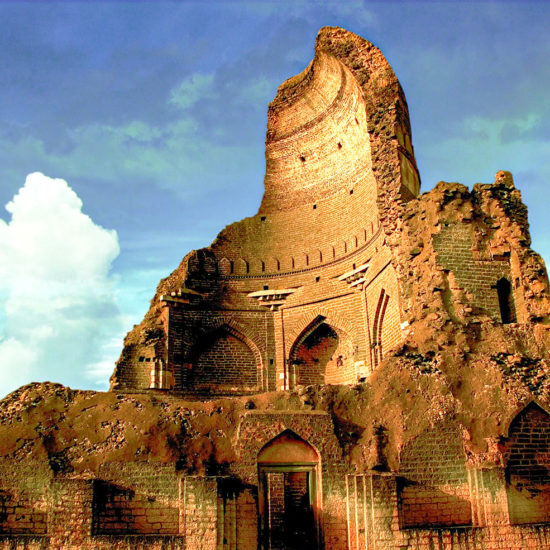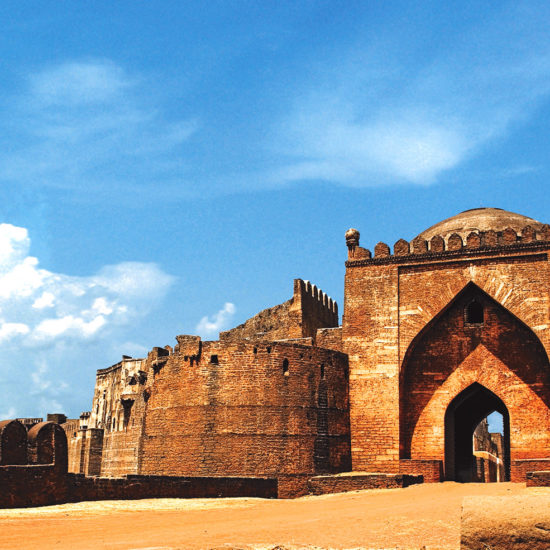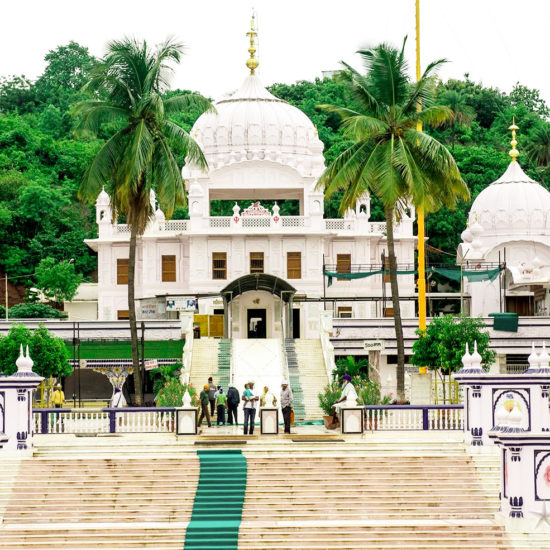Bidar, situated in the heart of the Deccan Plateau, has been a melting pot of cultural influences. A region that has seen dramatic changes in the course of its history, it is home to magnificent monuments. Ruled by the Kakatiyas, Tughlaqs, Bahamanis, Barid Shahis, Adil Shahis, Mughals and Nizams at different times, the architecture shows an interesting intermingling of Hindu, Turkish and Persian styles. Medieval Bidar was known not only as a capital city but as a centre of culture and seat of learning. Bidar is known for its Bidri handicraft products called Bidriware, and its rich history. Bidar is also home to Nanak Jhira Sahib considered one of the holiest places for Sikh pilgrimage in South India.
In the 12th century A.D., Bidar witnessed the rise of the Sharana (Veerashaiva) movement led by Basaveshvara, Allama Prabhu and others, which brought about a new chapter in social, religious, literary, cultural and economic fields and the influence it would have on the state.
Geographically, it is surrounded by Kalaburagi district on the southern side, Telangana State on the eastern side and Maharashtra State on the western and the northern side. Bidąr is Karnataka’s northernmost district and is often referred to as ‘Crown’ of Karnataka.
Bidar is also known for an ancient water supply mechanism known as Karez. Bidar is 690 kms from Bengaluru and has dry, hot weather during most of the year.
For further information, visit the official district website click here!
Fast Facts
When to go: Hot Weather during the summer months. Best from October to February
Tourist Office
Office of the Assistant Director
Department of Tourism
Deputy Commissioner Office Bidar
Tel: 08482-225262
Cell: 08884336435 (DTC)
Heritage Sites
- Bidar Fort: Amongst the most formidable forts of the country, it is situated in the eastern part of the town and has within it ruins of palaces, mosques and other buildings which had been built of trap rock. Stone and mortar were used to build the fort-walls. The fort is entered from the south-east by a zigzag passage protected by three gateways. The entrance gate has a lofty dome, the interior of which had been painted in bright colours. Bidar was the capital of Bahmani Kingdom in the 14th Bidar fort was built by Ahmad Shah Wali Bahman. Bidar fort was renovated in the 15th century by Sultan Ahmad Shah-I as he shifted his capital from Kulaburagi (Gulbarga) to Bidar.
- Bahamani Tombs, Ashtoor: Like the Egyptian pharaohs, the Bahamani kings were fond of building magnificent tombs to house themselves after death. Twelve imposing mausoleums are located at Ashtur east of Bidar. Of these, the tombs of Ahamad Shah and Alauddin Shah II stand out due to their grandeur.
- Basavakalyan: Located about 80km from Bidar, Basavakalyan was once the capital of the Kalyana Chalukyas and the centre of a great social and religious upheaval in the 12th century. Basavakalyan in Bidar district is famed for its cultural heritage and is known as the Karmabhoomi of Basaveshwara, the revered 12th century religious reformer. During his time, it became a seat of learning, and an abode of spiritual wisdom. Basavakalyan is renowned for the saints who made the city their home: Basaveshwara, Allama Prabhu, Akka-Mahadevi, Channabasavanna and Siddarama. You can also see some monuments like the Chaluckyan Fort, few caves, and other places of historic and religious importance here.
- Jalasangvi: Jalasangi is an ancient village near Humnabad in Bidar district. Jalasangi was the capital of King Virata and Pandava brothers are believed to have spent time here during their exile.
- Gagan Mahal (Heavenly Palace): A palace built originally by the Bahamanis, with additions made by Barid Shahi rulers, it has two courts. The main building was for the use of the Sultan and his harem.
- Diwan-i-Am (Public Audience Hall): Also called Jali Mahal, the building has two entrances, one through the east and the other through the west. At the backside of the main hall, there are three rooms. The central room was probably the Sultan's chamber where he sat before coming into the audience hall.
- Takhat Mahal (Throne Palace): Takhat Mahal had two side pavilions with lofty arches. It had a spacious hall, at the back of which was the Sultan's royal residence. Takhat Mahal is a stately building embellished with carvings and exquisite surface decorations. The coronations of several Bahamani and Barid Shahi Sultans were held here.
- Tarkash Mahal: Built as a residence for the Sultan’s Turkish wife, this palace was later extended by Barid Shahi rulers who kept large harems. The walls of the palace are highly ornamented and display stucco work.
- Rangeen Mahal: Rangeen Mahal literally means the coloured palace. A small but elegant palace, Rangeen Mahal is noted for its artistic quality. Its walls were originally decorated with tiles of different colours and had exquisite calligraphy. The walls of this Mahal are very thick and are of black stone which makes this a unique structure.
- Shahi Malbakh (Royal Kitchen): It is located adjacent to the Rangeen Mahal and it appears to have been the residence of a prince or some royal dignitary originally. Over time, it came to house the royal kitchens.
- Shahi Hamam (Royal Bath): Located near the royal kitchen is the Shahi Hamam where once upon a time the royals bathed in perfumed waters here. Quite nearby is the Lal Bagh (red garden) so named on account of its beautiful layout with red flowers grown here.
- Solah Khamb Mosque (16 Pillared Mosque): Located on the western side of the Lal Bagh, it is said to have been built in 1423-24 AD by Qubli Sultani. It is known so as it has 16 pillars in the middle part of the prayer hall. It is also called Zanana Masjid as it is situated near the Zanana enclosure. There is a well beyond the southern wall of the mosque.
Religious Places
- Guru Nanak Jhira Sahib Gurudwara: One of the very few Sikh pilgrimage centres in south India, the Guru Nanak Jhira Sahib nestles in serene surroundings near a splendid Gurudwara complex. A natural spring feeds the Sarovara (lake) built here. A Guru-ka-langar (community kitchen) provides free food to all visitors. According to a legend Guru Nanak, the famed social and religious Sikh reformer had visited Bidar while the land was in the grip of a famine. At the request of locals, Guru Nanak performed a miracle to bring about a spring of water from the laterite rock mountain. Till this day, crystal clear water flows from here. It is believed that drinking this water cures many ailments.
- Mohamud Gawan Madrasa, Bidar: Khwaja Muhammad Gilani (Mahmud Gawan) built this madrasa (college) at Bidar in 1472 AD. An imposing three-storied building, the Madarasa was a renowned centre of learning with its own library, lecture halls, quarters for professors/ students and a mosque. The institution had scholars imparting knowledge of Arabic and Persian languages, theology, philosophy, mathematics, etc. The front of the building is adorned with tiles of various colours along with two stately minarets on each side. Extracts from the holy Quran have been engraved on some parts of the walls, the remains of which can be seen.
- Jinwada: Jinwada in Bidar is considered a holy place by Sikh community who built Gurudwara Tap Asthan Mai Bhago.
- Veerabhadreshwara Temple, Humnabad: There is a well-known old temple dedicated to Lord Veerabhadreshwara here. Lord Veerabhadra here is seen with a sword in his right hand and shield with silver covering in his left. Just below the right hand, an idol with folded hands having the head of a goat can be seen which is called by the local people as Dakshabrahma. Nearby the garbhagriha are shrines dedicated to Goddess Bhadrakali and Lord Nandikeshvara. The shikara of the garbhagriha contains the figures of 28 leelas of Lord Shiva, 10 incarnations of Lord Vishnu and stories from the puranas. The annual jatra here is held around January-February. There are two huge pillars on either side of this temple and one of it is known as the 'Swinging Pillar' as a gentle push appears to make it sway a little.
- Ishvara Temple, Aliabad: The village has a small temple dedicated to Lord Ishvara, also called Rameshvara, in front of which there is a natural water-spring and a pond called "Papanash" (destroyer of sins). According to a legend, the linga in this shrine is one of the jyotirlingas (the sacred devotional representation of Lord Shiva worshipped in the form of a linga or the phallus symbol of the deity) and believed to have been worshipped by sage Shukracharya. Lord Rama is also said to have visited the place and worshipped at this shrine on his way back from Lanka to Ayodhya.
- Amareshvar Temple, Aurad: Aurad is home to the well-known temple of Amareshvar. Dedicated to Lord Amareswara, this temple is believed to be built in 10th century. The jatra of this temple is held for seven days during February - March every year. This village is also an important centre of cattle trade.
- Jharani Narasimha Cave Temple: This is an old Hindu temple dedicated to Lord Narasimha (an incarnation of Lord Vishnu). According to legends, Lord Narasimha after killing the demon Hiranyakashipu slew another one named Jharasura. As a dying request Jharasura requested Lord Narasimha to reside in his cave and so in granting this last wish, Lord Narasimha came to this cave. Devotees have to wade through chest-deep water for a glimpse of the deity carved on the wall of the cave. A good number of devotees visit this temple.
- Bhalki: Bhalki has an ancient fort built by Maratha rulers. Bhalkeshwara temple, Balamuri Ganapathi temple and Kumbheshwara temple are popular temples in Bhalki.
- Chandakapur: Popular for shrines of Ramalingeshwara, Somalingeshwara and Revanasidheshwara. Chandakapur is 20 kms south west of Basavakalyana town.
- Chintalgere: 22 kms south of Bidar town, Chintalgere is popular for annual fair at Veerabhadra temple.
- Chintaki: Popular for annual urus (memorial function) held at Shaik Sahab Dargah
- Chittaguppa: Popular for annual urus held in memory of Saints Salar Makdoom Shah and Karimula Shah
- Fathepur: Known for tomb of Fakhr-Ul-Mulk
- Hallikhed: Noted for its Naganathaswami temple and annual fair.
- Khanapur: Known for Mahaligeshwara temple
- Malkapur: Known for Sayyid Shah Muhib Ullah
Others
- Bidriware: In the historical town of Bidar, under the rule of the Bahamani Sultans in the 14th century, originated a unique metal ware – the Bidriware. On a blackened alloy of zinc, tin, lead and copper, inlaid with thin sheets of pure silver, craftsmen work their magical filigree. All the process of making the Bidriware starting from casting to oxidation is done by hand and therefore it is time consuming and hence costlier too. The hookahs, goblets, plates, pen holders, vases, even bangles with patterns of vines, delicate floral motifs are a vision to behold. Bidriware also has a Geographical Indication (GI) tag under the World Trade Organisation.
- Karez System: Karez system refers to a unique water harnessing technology popularly used in Bidar district. The Karez system taps into ground water sources and transports water via underground tunnels to areas of consumption (fields and residential areas). The Karez system has its origins in Iran/Persia and dates back to almost 500 years.
- Karanja Project: Karanja irrigation project on Karanja river in Bidar is facilitated with Karanja Dam. The scenic location is also popular as a picnic/holiday spot.
- Kallur: Known for Basava Tirtha Mandir and Veerashaiva Matha
- Manik Nagar: Manik Nagar is a fine modern village in Bidar and known for Samadhi of Saint Manik Prabhu.
- Molkhera: Popular for cave of Saint Moligemarayya
- Sangam: Confluence of Karanja and Manjra rivers, with a shrine of Sangameshwara.
- Taljiapur: Small village housing samadhi of Dattananda Swamiji and home to Ishwara, Hanuman and Ganesha temples.
- Morkhandi: An ancient village with ruins of Badami Chalukya era temple.
Tourist Attractions
- Deva Deva Vana: Deva Deva Vana literally means 'forest of divine/ celestial beings'. A botanical garden maintained by the Forest Department, around 6 km from Bidar on Bidar – Hyderabad Highway. It is home to around 200 medicinal plants and trees, and is considered sacred. A map of a garden shows the location of various gardens here. It is divided into around 10 gardens and a nursery which is classified according to a particular theme like Nandana Vana, Ashoka Vana, Navagraha Vana, Rock Garden, Shiva Panchayath Vana, Phala Pushpa Vana, etc.
- Chaubara: Located in the centre of Bidar city, this is a 22m high cylindrical watch tower called Chaubara (meaning four directions) and one gets an excellent view of the plateau around the city, from the top.
Tour Location
Bidar is well connected by rail, road and air. Bidar is 690 kms from Bengaluru and 150 kms from Hyderabad.

Eco:
Jungle Lodges runs Blackbuck resort
Vilaspur taluk, 19 kms from Bidar city Email ID: info@junglelodges.com Website: Click here





